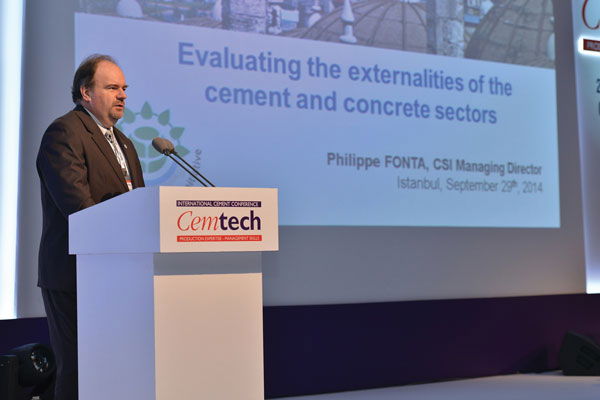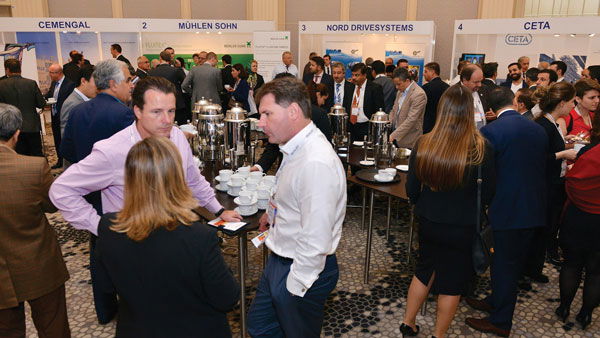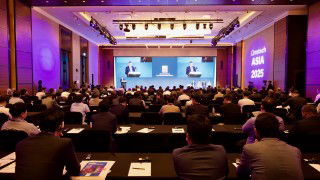The stunning city of Istanbul, Turkey, played host to Cemtech Europe 2014 over 29 September - 1 October, attracting an audience of 320 delegates from 35 countries. Supported by the Turkish Cement Manufacturers' Association (TÇMB), the event proved to be a major success with an expert conference programme, extensive networking opportunities, exquisite hospitality and an exclusive tour of Nuh Çimento’s cement works all combining to deliver the ultimate conference experience in the heart of Turkey’s historic capital.

Cemtech Europe 2014 draws an international audience of 320 delegates from 35 countries across the world
Istanbul, the magical meeting place of east and west, proved a popular choice as Cemtech Europe 2014 welcomed industry specialists from across Europe and beyond, including cement producers from Thailand, Yemen, Saudi Arabia, Egypt and the UAE. Throughout the three-day event, the senior level audience were able to draw on abundance of major industry talking points as Cemtech’s comprehensive programme covered all the latest major corporate, market and technological developments: from the industry’s biggest- ever merger, to experiences of recent cement plant projects across Europe, as well as the latest techniques to optimise plant performance and improve energy efficiency.

Çaglan Becan of the Turkish Cement Manufacturers’ Association
provides an overview of cement activity in the host market
After a warm welcome from the Cemtech conference organisers, conference proceedings began with an overview of cement activity in the dynamic host market of Turkey by Çaglan Becan of the Turkish Cement Manufacturers' Association (TÇMB). As well as being Europe’s largest cement market, Turkey remains one of the world’s top five producers and has held a position within the top two exporters globally over the last decade. With the government’s urbanisation and infrastructure development plans set to be the key drivers of demand growth, new projects continue to be established. According to TÇMB figures, production is expected to increase from 77Mt by the end of 2014 to around 98Mt in 2020. Producers have also turned their attention towards environmental improvements, alternative fuels and energy optimisation. Ms Becan explained that a key priority is the development of alternative energy and raw materials, including the use of urban and industrial wastes. As such, a number of waste heat recovery (WHR) projects are ongoing in the sector and the development of low-temperature heat generation is being explored.
A new era emerges
Following on, Cemtech regular Jean-Christophe Lefèvre-Moulenq of CM-CIC Securities (France) provided expert analysis on the global cement industry’s most dominant topic – the rationale behind the Lafarge and Holcim mega merger and its likely effect on the European cement industry. As the traditional Big 5 cement producers adjust to new market realities in Europe and have to contend with a new breed of emerging giants, Mr Lefèvre-Moulenq believes the merger is the only route forward for the world’s top two companies. Moreover, he anticipates that the move is likely to trigger further consolidation in Europe, with other strategic alliances potentially in the pipeline. .

The opening session featured an analysis of the social and
economic role played by the cement and concrete sectors in
Europe by Philippe Fonta, managing director of the
Cement Sustainability Initiative
Phillipe Fonta, managing director of the WBCSD’s Cement Sustainability Initiative (CSI), was then welcomed on to the Cemtech stage to provide an analysis of the social and economic role played by the cement and concrete sectors in Europe. The CSI has decided to initiate and conduct a broad analysis of the externalities of both sectors, both in an environmental and social context to ensure the sector is at the forefront of sustainability thinking and actions. As a first step, the CSI members will collectively develop the scope, boundaries and timeline of this project to best accommodate the various available resources, and will present them for discussion and validation at the next CSI CEO meeting in December 2014.
Supply and demand updates
Mehmet Gürses of Aslan Çimento (Oyak Group) presented a detailed insight into the evolution of Turkish cement and clinker exports over the last five years.
The country’s international shipments have been sensitive to events in neighbouring markets, but Turkey remains the world’s second largest exporter having been overtaken by Iran in 2012. Mr Gürses explained that Turkish cement and clinker quantities have fallen by about 41 per cent (or 8.4Mt) from a peak of 20.2Mt in 2009 to 11.8Mt in 2013. Sales have lost ground in key markets in recent years due to three prime reasons: political turmoil and uncertainty (ie, the MENA region), sovereign debt crises (Spain, Italy, Greece), and the improving self-sufficiency rates of certain countries which are limiting the need for imports (Russia and Iraq). However, Mr Gürses stressed that Turkish cement producers have been able to help mitigate declining exports by serving increasing domestic demand needs amid a better pricing environment.
A prime example of Turkey’s heavy investment in large-scale infrastructure is the construction of the Third Bosphorus Bridge Project – a colossal undertaking consisting of highways, connection roads and a bridge over the Istanbul Strait. Akçansa Cimento (jointly-owned by Sabanci Holdings and HeidelbergCement) has been awarded a supply contract for the Third Bosphorus Bridge project, totalling 1Mm3 and 240,000m3, respectively. Hakan Gürdal, newly-appointed chairman of Sabanci Holdings, explained the specifications of Akçansa’s scope of supply. Using special slip-forming techniques, concrete setting times must be manipulated several times during the project. The tip of the pylons are 330m tall (higher than the Eiffel Tower) and pumping concrete at such distance will be a record-breaking achievement in Turkey. Among the many durability requirements, to prevent alkali aggregate reaction, low-alkali cement will be used according to specification. To comply with this requirement, Akçansa’s Büyükçekmece plant will produce a specially-engineered low-alkali cement.
Delving into Iranian cement industry trends, Dr Lotfali Bakhshi of Mehr Machine (Iran) shared some of the latest updates from a country which has seen cement capacities rocket and export levels surge in recent years. Iran is currently home to 77 cement plants with an installed capacity of 96Mta. Production output in 2013 totalled 69Mt and exports during the year reached 18.8Mt, making it the world’s leading exporter. The growth in cement capacity has led to a surplus situation which the country is addressing by closing inefficient units, changing grey cement kilns to white cement capacity and further increasing export levels. Dr Bakhshi noted that in the past eight years, 17 kilns under 1000tpd have been closed and in the last four years three small kilns have been converted to white cement units. In terms of exports, this year the country targets about 20Mt. Moreover, producers are also establishing cement packing plants and mills in neighbouring countries with several projects under consideration in Afghanistan and Iraq.
Establishing & financing new plant projects
Roberto Fedi and Matteo Maconi of CTG Italcementi (Italy) updated delegates on two important European plant projects currently under progress by the Italian cement major. Together, they shared experiences of combining European and Chinese technologies in the company’s Devnya (Bulgaria) and Rezzato (Italy) modernisation projects as the company remains committed to improving efficiency and environmental performance in its industrial network. Both lines are expected to start up shortly, just in time to celebrate Italcementi’s 150th anniversary.
Turning attention back to Turkish industry activity, Oral Türesay of KHD Humboldt Wedag provided a technical review of recent new capacity and modernisation contracts the company has undertaken in a country where the appetite for new cement projects remains strong. The Turkish cement industry has been a key market for the German equipment supplier, and following the completion of several successful projects, the pace of orders has quickened. In this year alone, successful performance tests of second production lines at Kahramanmaras Çimento and Askale Çimento’s Van cement plant have been completed.
An overview of NORM Cement’s 2Mta Qizildas greenfield plant – the latest addition to Azerbaijan’s expanding production base – was showcased by the company’s Hasan Yalcinkaya. With September 2014 marking a year since the launch of production, Mr Yalcinkaya provided an overview of the project scope – from preparation to operation – as well as provided a timely overview of performance results. The raw mill has exceeded guaranteed performance of 420tph with a realised output of 425tph. Meanwhile, guaranteed kiln and grinding capacities of 5075tpd and 148tph for CEM II/A 42.5 have been achieved, respectively.
The financing of cement plant projects in emerging markets was the focus on an informative presentation by Florence Bachelard-Bakal of the European Bank for Reconstruction and Development (EBRD). As at the end of 2013, cement proved to be the largest part of the EBRD’s building materials portfolio. The development bank assists industrial plants in reaching internationally-accepted environmental standards and in reducing pollution of existing plants, as well as developing dedicated energy efficiency loans or energy efficiency components within broader investment programmes. Both established and new names have been supported by the EBRD including Lafarge (in Slovenia, Poland and Romania), Holcim (Azerbaijan), Antea Cement (Albania), and Senj Sant (Mongolia).
| Technical Workshop |
| Following the conference and exhibition, Cemtech welcomed a second cohort of cement plant engineers to the Technical Workshop held over three days at the Conrad Istanbul. Led by Dr Michael Clark – Technical Consultant for International Cement Review with over 30 years’ experience in the cement industry – the course provided a detailed review of the entire cement manufacturing process from quarry to factory gate, taking students from the fundamentals of production technology all the way through to practical strategies for optimising operations. Through presentations, discussion and a series of Excel-based exercises, participants gained new insights into pyroprocessing, mill productivity and cost minimisation. New trends in energy and alternative fuel utilisation was another key focus of the course, which offers participants the chance to identify new opportunities in this growing field. With participants hailing not only from Europe and Turkey, but north Africa and the Middle East, the course’s universal relevance and commitment to applying theoretical concepts to practical cement plant operations were especially well received. Cemtech looks forward to launching this course in the Middle East next February alongside Cemtech MEA 2015. For more information, please visit: www.Cemtech.com/MEA2015/Workshop |
Technical advances
Wide-ranging technical content included ways to overcome process challenges and examples of new technologies successfully implemented in the region to improve reliability, performance and efficiency.
Jaroslav Stoupa of Russia-based LSR Cement – NW LLC provided an interesting process design case study on utilising raw materials with a high organic content at its Slantsy cement works in Russia.
Computational fluid dynamics (CFD) was the focus of a paper by Pietro Aresta of FLSmidth (Denmark) who explained how well-developed internal fluid-dynamics can positively impact the performances of a fabric filter. Following on, Matthias Mersmann of aixergee (Germany) described how CFD was used to reduce NOx emissions by 16 per cent to 186mg with the SNCR system at Holcim’s Eclépens works in Switzerland – thereby “beating the 200mg limits without SCR.”
Energy management, alternative fuels and co-processing featured prominently on the conference agenda. A paper by Con Manias of FCT International (Australia) focussed on burner design considerations for optimum results when trying to achieving high substitution of alternative fuels. Industry consultant Arthur Harrisson then explained how to address quality issues in clinkers produced with alternative fuels.
The successful applications of alternative fuels systems in Turkey were shared by Luc Rieffel of Walter Materials Handling/ ATS Group. The presentation largely concentrated on how the French materials handling specialists has helped two Turkish plants increase their substitution rates, one using RDF, and the other using RDF and whole tyres simultaneously at different flow rates.
Revamping fans can be an economic way of improving plant performance and availability, and Laurent Tisserand of Howden France demonstrated through a number of case studies how, by optimising a fan for its current operating conditions or upgrading it to reduce power consumption or wear, savings can be made in running costs.
Other highlights of the technical programme included case studies by Carsten Wiedmann of Thermo Fisher Scientific (Germany) on raw mix proportioning, clinker formation and clinker cooling optimisation. Nicolas Gouez of CMD Gears (France) provided examples of successful operations with the company’s Bogiflex kiln gear drive. ABB’s Juliano Arantes reported on advanced process control successes at Akçansa’s Canakkale cement factory. Jeff Shelton of Martin Engineering (USA) talked delegates through how it is changing the way preheater towers are kept clean with specific reference to a multi-port air cannon installation at Leube Zementwerk (Austria).
A joint paper by Martin Weibel and Jorg M Schrabback of Sika Services explained how the company has mastered the challenge of analysing what happens with grinding aid molecules during cement grinding. The presentation described how the findings help to design tailor-made products for the challenges faced by cement plants.
Moving on to packaging advances, Wolfgang Schulte of Beumer Maschinenfabrik described how the replacement of a rotary packer by a Beumer fillpac RC at PPC’s Riebeeck plant in South Africa has enabled easier and more reliable control of the bag application. Finally, Ercument Yildiz of GE (Turkey) outlined the attractive paybacks that can be achieved by using modular ORC systems to capture low-grade waste heat below 300°C.
Engaging with the experts
A packed 40-stand exhibition area with accompanying hospitality suites proved a lively arena in which delegates could engage with some of the world’s leading equipment suppliers to the cement industry. This international showcase for suppliers provided further scope for the transfer of ideas, highlighting some of the best new approaches to optimise the cement production process.

A 40-stand exhibition area and additional hospitality suites provided an excellent
arena for the exchange of ideas on a one-to-one basis
A Nuh perspective
An eagerly-anticipated site visit to Nuh Çimento’s cement works, did not disappoint as delegates were able to learn more on the capabilities and innovations at this independently-owned plant.
With three kiln lines with a capacity of 4.4Mta, Nuh Çimento operates one of the largest clinker capacity plants in Turkey and has a cement capacity of 5.5Mta.
Enhancing energy efficiency and improving environmental performance has been high on list of Nuh Çimento’s priorities. Recent investments include a 250tpd waste sludge dryer unit which has cut fuel consumption in Kiln 3 by three per cent, a 5tph automatic RDF feeding system to facilitate alternative fuels usage, and seawater purification facility. A 17MW hydroelectric power plant takes total energy production capacity at the cement works to 175MW.
Turkish delights
Accompanying partners were also kept busy with complimentary sightseeing tours of many of Istanbul’s top-draw attractions with visits to the Blue Mosque, Topkapi Palace and Hagia Sofia, as well as shopping expeditions to the lively Grand Bazaar and a leisurely boat tour along the Bosphorus, taking in some of the city’s amazing historic sites.
Networking opportunities continued in more relaxed surroundings including five-star lunches and evening receptions. A glamorous Gala Dinner with a Turkish flair provided the perfect finishing touch to official proceedings. Highlights included mesmerising whirling dervishes as well as a modern twist on the traditional belly dance synonymous with Turkey.

An exceptional Gala Dinner concludes official proceedings with a final flourish
With the close of another hugely successful Cemtech event, attention now turns to the 10th edition of our Middle East and Africa Conference and Exhibition, which returns to the sunny climes of Dubai, UAE, over 8-11 February 2015. For more information, visit: www.Cemtech.com/MEA2015
